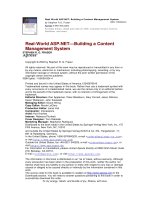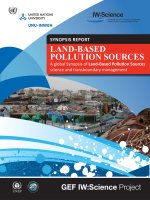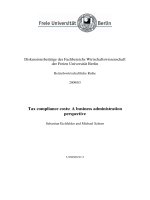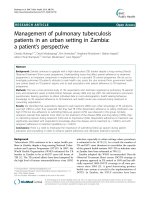Chemicals, Environment, Health: A Global Management Perspective ppt
Bạn đang xem bản rút gọn của tài liệu. Xem và tải ngay bản đầy đủ của tài liệu tại đây (8.53 MB, 810 trang )
Chemicals,
Environment,
Health
A Global Management PerspectivePhilip Wexler, as part of the editorial team, contributed to this book in his capacity as a private citi-
zen, not as a government employee. The views expressed are strictly his own. No official support or
endorsement by the U.S. National Library of Medicine or any other agency of the U.S. Federal Govern-
ment was provided or should be inferred.
CRC Press
Taylor & Francis Group
6000 Broken Sound Parkway NW, Suite 300
Boca Raton, FL 33487-2742
© 2012 by Taylor & Francis Group, LLC
CRC Press is an imprint of Taylor & Francis Group, an Informa business
No claim to original U.S. Government works
Version Date: 20110623
International Standard Book Number-13: 978-1-4200-8470-2 (eBook - PDF)
This book contains information obtained from authentic and highly regarded sources. Reasonable
efforts have been made to publish reliable data and information, but the author and publisher cannot
assume responsibility for the validity of all materials or the consequences of their use. The authors and
publishers have attempted to trace the copyright holders of all material reproduced in this publication
and apologize to copyright holders if permission to publish in this form has not been obtained. If any
copyright material has not been acknowledged please write and let us know so we may rectify in any
future reprint.
Except as permitted under U.S. Copyright Law, no part of this book may be reprinted, reproduced,
transmitted, or utilized in any form by any electronic, mechanical, or other means, now known or
hereafter invented, including photocopying, microfilming, and recording, or in any information stor-
age or retrieval system, without written permission from the publishers.
For permission to photocopy or use material electronically from this work, please access www.copy-
right.com ( or contact the Copyright Clearance Center, Inc. (CCC), 222
Rosewood Drive, Danvers, MA 01923, 978-750-8400. CCC is a not-for-profit organization that pro-
vides licenses and registration for a variety of users. For organizations that have been granted a pho-
tocopy license by the CCC, a separate system of payment has been arranged.
Trademark Notice: Product or corporate names may be trademarks or registered trademarks, and are
used only for identification and explanation without intent to infringe.
Visit the Taylor & Francis Web site at
and the CRC Press Web site at
For my parents (Yetty and Will), my son (Jacob), and dear Nancy
Philip Wexler
For my wife, Jeanette, who accompanied me in many ways during a
40 year journey promoting chemical safety
Jan van der Kolk
For my loving wife, Sarah, my Mom (Kanak) and Dad (Mahendra)
Asish Mohapatra
To my father
Ravi Agarwal
ix
Contents
Foreword xiii
Preface xv
Editors xix
Contributors xxi
SECTION I The Context
Chapter 1 Creating and Controlling Chemical Hazards:
A Brief History 3
Jody A. Roberts
SECTION II Conferences
Chapter 2 Stockholm 1972: Conference on the HumanEnvironment 17
Lars-Göran Engfeldt
Chapter 3 Rio 1992: The UN Conference on Environment and
Development(The “EarthSummit”) 27
Shelley Kath
Chapter 4 Johannesburg 2002: TheWorld Summit on
Sustainable Development 63
Shelley Kath
Chapter 5 International Conference on Chemicals Management 1, ICCM-1 83
Linn Persson and Viveka Bohn
Chapter 6 International Conference on Chemicals Management 2, ICCM-2:
Cementing Process and Making Progress toward the2020Goal 91
Melanie Ashton and Pia M. Kohler
x Contents
SECTION III Global/Multilateral Instruments
Chapter 7 The Aarhus Convention: Impact on Sound Chemicals
Managementwith Special Emphasis on Africa 103
Ebeh Adayade Kodjo
Chapter 8 The Basel Convention—A Promising Future 121
Pierre Portas
Chapter 9 The Climate Change Convention and the Kyoto Protocol 135
Bert Metz
Chapter 10 Convention on Long-Range Transboundary AirPollution 155
Johan Sliggers
Chapter 11 The Globally Harmonized System of Classication and
LabellingofChemicals: The System, Its History
andContext,andtheFuture of Implementation 171
Cheryl Chang
Chapter 12 The International Code of Conduct on Distribution and
UseofPesticides 187
Gamini Manuweera
Chapter 13 The Kiev Protocol onPollutant Release and
Transfer Registers 203
Michael Stanley-Jones
Chapter 14 The Rotterdam Convention 213
Ernest Mashimba
Chapter 15 Implementing the Stockholm Convention: An Increasingly
ExpensiveChallenge 229
Pia M. Kohler and Melanie Ashton
Chapter 16 The Vienna Convention, Montreal Protocol, and Global
PolicytoProtect Stratospheric Ozone 243
David Downie
Contents xi
SECTION IV SAICM
Chapter 17 Strategic Approach to International Chemicals Management:
Development and Opportunities 261
Hamoudi Shubber
SECTION V Organizations
Chapter 18 Food and Agriculture Organization of the United Nations 285
Mark Davis
Chapter 19 International Chemicals Management within the Global
Environmental Governance Context 301
Achim Halpaap
Chapter 20 Managing Chemical Risks: The Role of the Chemical Industry 311
Michael Walls
Chapter 21 The Intergovernmental Forum on Chemical Safety 329
Jack Weinberg
Chapter 22 International Labour Organization’s Activities in the Area
ofChemical Safety 343
Pavan Baichoo
Chapter 23 Inter-Organization Programme for the Sound
ManagementofChemicals 355
Jan van der Kolk
Chapter 24 The International Panel on Chemical Pollution 359
Martin Scheringer, Åke Bergman, and HeideloreFiedler
Chapter 25 The Role of the International POPS Elimination Network 371
Mariann Lloyd-Smith
xii Contents
Chapter 26 Organisation for Economic Cooperation and Development 383
Richard Sigman
Chapter 27 The Chemical Weapons Convention and the Work of the
Organisationfor the Prohibition ofChemical Weapons 391
Boitumelo V. Kgarebe and Cristina B. Rodrigues
Chapter 28 National and International Scientic Societies’ Role in
GlobalCollaboration in Chemicals Management 407
John Duffus
Chapter 29 The Role of United Nations Development Programme in
SoundChemicals Management 419
Jan van der Kolk
Chapter 30 United Nations Environment Programme and
UNEP Chemicals 427
Jan van der Kolk
Chapter 31 United Nations IndustrialDevelopment Organization 435
Heinz Leuenberger and Elisa Tonda
Chapter 32 United Nations Institute for Training and Research 443
Craig Boljkovac and Jan van der Kolk
Chapter 33 The Contributions oftheWorld Health Organization
toSoundChemicals Management 453
John A. Haines
Chapter 34 The Intergovernmental Panel on Climate Change 477
Bert Metz
SECTION VI Representative Country Implementations
Chapter 35 Chilean Approach to Chemical Safety and Management 489
Sergio Peña Neira and Asish Mohapatra
Contents xiii
Chapter 36 Chemical Management System in China: Past, Present, Future 503
DaeYoung Park
Chapter 37 Chemicals in Egypt: A Generic Perspective 517
Mohamed Tawc Ahmed and Naglaa M. Lout
Chapter 38 Capacities for Chemicals and Pesticides Management in Ghana 531
John A. Pwamang
Chapter 39 Chemicals Management and Safety in India 541
Ravi Agarwal
Chapter 40 São Tomé and Príncipe and the Issue of Persistent
Organic Pollutants 567
Arlindo Carvalho
Chapter 41 Activities, Challenges, and Accomplishments of the Republic of
Slovenia in the Implementation of Chemical Management
Instruments 575
Marta Ciraj
Chapter 42 Implementation of the Rotterdam Convention inThird
WorldCountries: The Tanzania Experience 591
Ernest Mashimba
SECTION VII Regional Activities
Chapter 43 Tripartite Environmental Collaboration between China,
Japan,andKorea in Chemical Management 607
DaeYoung Park
Chapter 44 REACH: Next Step to a Sound Chemicals Management 617
Arnold van der Wielen
Chapter 45 North America Cooperation in Chemical Management 637
Asish Mohapatra and Philip Wexler
xiv Contents
Chapter 46 Regional Cooperation among South Asian Association for
RegionalCooperation Countries in the Areas of Chemical
andEnvironmental Risk Management 655
Lakshmi Raghupathy, Asish Mohapatra, RaviAgarwal,
andJanvander Kolk
SECTION VIII Invited Essays
Chapter 47 A Global Approach toEnvironmental Emergencies 669
Chris Dijkens and Peter Westerbeek
Chapter 48 Emerging Issues in Global Chemical Policy 689
Franz Perrez and Georg Karlaganis
Chapter 49 Financing Instruments Related to Chemicals and
Waste Management 727
Ibrahima Sow
Chapter 50 Information Resources Supporting Global Chemicals Policy
andManagement 739
Asish Mohapatra and Philip Wexler
SECTION IX Future Outlook
Chapter 51 Future Outlook and Challenges 761
Jan van der Kolk and Ravi Agarwal
Appendix A: Abbreviations 771
Appendix B: Web Sites 783
xv
Foreword
The past 40 years have seen a phenomenal growth in globally oriented public and
private initiatives related to chemical and other environmental issues. The ground-
breaking 1972 United Nations Conference on the Human Environment held in
Stockholm, in which I was honored to play a role, ushered in a veritable sea change
in international environmental policies. It gave rise to the rst World Environment
Day and the creation of the United Nations Environment Programme. It put the envi-
ronment on the international agenda as a global concern, which must be and could be
reconciled with economic development as two sides of the same coin. This led the
way to the acknowledgment that sustainable development is the most logical and
viable pathway to the human future.
Over the years, one conference, or rather milestone, led to another—Stockholm to
Rio to Johannesburg—with many intervening activities. Stakeholders who played an
inuential though limited role in 1972 from outside of the Conference were brought
into the fold to offer their unique perspectives. The developing world, which suffered
most from environmental degradation, yet did not have the resources to ameliorate it,
asserted its insistence that more developed countries provide the new and additional
resources they would need to address their environmental problems. Although steps
have been taken, the ever widening gap between South and North has still to be suc-
cessfully addressed. By many measures, we are better off than we were in 1972. With
more emerging issues, such as new technologies, and much greater knowledge, formi-
dable challenges remain. What is most important is that the dialogue has been estab-
lished, is continuing and mechanisms have been created that contribute to solutions of
many problems. Governance has now also become a subject in its own right, as criti-
cal to many successful approaches. So are linkages between chemicals management
and other health and environmental problems. Indeed, on an even broader level, so
isthe concept of environmental mainstreaming, in which considerations about the
environment (including chemicals) are integrated fully into decision making in the
economic, social, and physical realms of development.
The very capable editors of this book have assembled a distinguished roster of
contributors to create a valuable guidebook to global chemicals management coop-
eration as it stands today and is projected to evolve in the future. An opening back-
ground chapter setting the historical and contextual framework is followed by
chapters covering the major conferences, international treaties and conventions, and
organizations. Select regional and national activities round out the scope of the book.
Invited essays in such diverse areas as emergencies, information resources, global
nancial instruments, and governance further supplement the core text. Naturally,
today’s major policy framework, the Strategic Approach to International Chemicals
Management (SAICM) and its associated International Conference on Chemicals
Management (ICCM), are also highlighted. Finally, a concluding chapter analyti-
cally presents a look at the future of global chemicals policy.
xvi Foreword
This is not the rst book to consider chemicals, environment, and health from a
global perspective, but it is the rst to do it so thoroughly and concisely, without get-
ting bogged down in a litany of legalistic detail. The chapters consistently offer pre-
cision, perspective, and reection, and will be appreciated not only by the professional
policy community, but to anyone wanting a clear look through the complex maze. I
applaud this contribution to global environmental knowledge and understanding,
and appreciate the opportunity to introduce it to both experienced hands at the sub-
ject and the new generation of researchers and practitioners. It is a book to read
straight through or savor a section at a time, and belongs on the bookshelf of any-
one interested in making a difference in the way we and future generations will live
our lives in a world in which our health, and the environments, will no longer be
endangered by potentially hazardous chemicals at any stage of their life cycle.
Maurice F. Strong
Founder and Chairman of Cosmos International Inc.,
Honorary Professor of Peking University (Beijing), and
Honorary President, Oriental Environment Research Institute (China)
Maurice F. Strong has had a remarkable career in both business and public service,
primarily in the elds of international development, the environment, energy and
nance. He has played a unique and pioneering role in globalization of the environ-
ment movement as Secretary-General of both the 1972 United Nations Conference
on the Human Environment, which rst put the environment on the international
agenda, and the 1992 Rio Earth Summit. He was the rst Executive Director of the
United Nations Environment Programme. Strong continues to be active in environ-
ment and related elds, particularly in China (a country he has had a long relation-
ship with and where he now spends much of his time). To learn more about Maurice
Strong’s illustrious career, visit .
xvii
Preface
INTRODUCTION
Chemicals are ubiquitous. Man has been aware of naturally derived chemicals for
thousands of years, while synthetic chemicals have been with us for perhaps 200
years, with both performing a variety of important functions in our lives.
The toxicity of certain chemicals to man and animals has also been known since
antiquity.
Chemical industry as producer of many new molecules for different purposes is
however, relatively young, a little more than a century. In that period of time, the
number of new molecules and the volumes of their production have increased tre-
mendously. With more than 56 million organic and inorganic chemicals registered
with the Chemical Abstracts Services of the American Chemical Society as of late
2010, and nearly 100,000 in commerce, they are having an increasingly huge impact
on our lives.
AWARENESS
With this rapid growth in chemical synthesis, distribution, use, and subsequent expo-
sure, society eventually realized the need to manage chemicals in a sound way, albeit
often with delays. The need to protect workers, globally, from potentially harmful
effects began as early as 1921 with the ILO (International Labour Organization)
Convention to ban white lead in most paints. This convention subsequently proved to
be benecial for the larger population groups (e.g., countries that had implemented
this Convention had hardly any problems with children affected by white lead from
paint indoors).
As a class of chemicals, pharmaceuticals were subject to early regulatory con-
trols, long after it became clear that the same substances that could cure illnesses
could also be toxic for the patient.
Pesticides were another group to receive wider attention, both to assure that their
benecial effects were optimized and to control unwanted side effects. For example,
in the United States, the Pure Food and Drugs Act and the Federal Insecticide Act
were passed in 1906 and 1910 respectively. In fact, many early regulations, including
those for foodstuffs, pharmaceuticals, and pesticides, centered rst on quality and
later on safety. Pesticide regulations were introduced in many countries in the rst
half of the twentieth century. The awareness of the potentially harmful effects of
chemicals, particularly pesticides on the environment reached, in a sense, its water-
shed moment soon after the publication of Rachel Carson’s Silent Spring in 1962.
Further efforts to control worker exposure to hazardous industrial chemicals
started in the mid-1960s. These resulted in schemes for classication and labeling, as
well as regulations for transport, to prevent accidents.
xviii Preface
The 1960s witnessed a number of environmental problems traceable to chemical
waste. One of the most well known is the Love Canal site in the United States. Later,
many thousands of heavily contaminated sites were discovered. In the Netherlands,
entire urban areas were destroyed in the 1970s after it had become clear that houses
had been built on a previous chemical waste dump. In the same decade, numerous
instances were uncovered of contaminated sites in developing countries. These were
due to dumping of chemical and pesticide waste and/or the uncontrolled import of
chemical waste.
MANAGEMENT, INSTRUMENTS, AND CHALLENGES
International attempts to address chemical safety could be said to truly begin with
the 1972 Stockholm Conference, which resulted in the creation of UNEP (United
Nations Environment Programme) and, shortly thereafter, the predecessor of what is
today UNEP Chemicals.
Since this Conference, and in particular since the UNCED (United Nations
Conference on the Environment and Development) in 1992 in Rio de Janeiro, many
initiatives have been undertaken to address the potentially harmful effects of chemi-
cals. Most recently, in 2002, in Johannesburg, South Africa, the World Summit on
Sustainable Development, building upon the Rio conference, articulated the often
cited goal of ensuring that chemicals are produced and used in ways that minimize
signicant adverse impacts on the environment and human health.
This book seeks to give a full overview of these developments and their impacts
at international, and select regional and national levels. Further, it offers an outlook
for the next 5–10 years—specically, of the current challenges that need to be
addressed to meet the goals that the international community set in Johannesburg
in 2002.
The United Nations will be holding another conference on sustainable develop-
ment in Rio in May 2012, 20 years after the historic 1992 conference, and thus
already being informally referred to as Rio + 20. The conference will seek three
objectives: securing renewed political commitment to sustainable development,
assessing the progress and implementation gap in meeting already agreed commit-
ments, and addressing new and emerging challenges. The members have agreed to
the following two themes: green economy within the context of sustainable devel-
opment, and poverty eradication, and institutional framework for sustainable
development.
INTEGRATION OF CHEMICALS IN WIDER SUSTAINABLE
DEVELOPMENT
Chemicals are but one, albeit important, topic on the international environment and
health agenda. However, they touch upon a host of other issues of critical importance
to health and the environment: climate change (several chemicals are important con-
tributors to global warming or the depletion of the ozone layer), biological diversity
(certain chemicals are known to affect ecosystems in various regions of the world),
Preface xix
transmissible diseases (consider the continuing debate of the role of certain pesti-
cides in malaria control), poisoning incidents (most cases of poisoning worldwide
are attributed to abuses of pesticides). In this sense, almost all the Millennium
Development Goals, established by the United Nations, with a target date of 2015,
have a direct or indirect link with chemicals management. To cover all these, though,
would take several more volumes.
Several key lessons have gradually been learned over the years.
First, many instruments have developed separately and without much coordina-
tion. This has signicantly complicated work both at international and national
levels. Only recently, attempts to streamline have resulted in more concrete and inte-
grated actions (i.e., enhancing synergies between the Basel, Rotterdam, and
Stockholm Conventions). Much work still remains to be done in this area.
Second, chemicals management and its instruments have mostly been looked at as
a technical and specialized niche area, somehow removed from other societal
concerns. This, notwithstanding the key importance of chemicals and chemistry for
all areas of the economy and development, and the scientically indisputable nega-
tive effects of several dozen chemicals on health or the environment worldwide. Very
few attempts have been made to link chemicals management to the wider sustainable
development agenda, or to broader mechanisms, including nancial instruments, or
development planning in general.
This book addresses not only the individual instruments and their implementa-
tion in several regions and countries, but also underpins the need for such further
integration.
OVERVIEW
Since the 1972 Stockholm Conference, a number of books, papers, and monographs
have discussed problems and situations related to chemicals management. These
publications have largely dealt with key issues as seen from a specic perspective.
This book is the rst to bring together, in a cohesive manner, history, legal and
other instruments, roles of international organizations, capacity strengthening initia-
tives, and accomplishments at all governmental levels.
Philip Wexler
Jan van der Kolk
Asish Mohapatra
Ravi Agarwal
xxi
Editors
Philip Wexler is a Technical Information Specialist at the National Library of
Medicine’s (NLM’s) Toxicology and Environmental Health Information Program.
He is the federal liaison for the Toxicology Education Foundation and the World
Library of Toxicology. He coordinates and manages NLM’s risk-assessment infor-
mation databases and online tools on the TOXNET system, and is project manager
of the LactMed le on drugs and lactation. He is team leader for the development of
the ToxLearn online tutorials, a joint activity with the U.S. Society of Toxicology
(SOT). Served as chair, for two years, of SOT World Wide Web Advisory Team, he
is President of the Society’s Ethical, Legal, and Social Issues Specialty Section in
2009–2010. He has coorganized the Toxicology History Room for a variety of pro-
fessional meetings. He was a member of the Education and Communications Work
Group of the CDC/ATSDR’s National Conversation on Public Health and Chemical
Exposure project. Wexler has published numerous papers on toxicology information
and has lectured and taught widely on the subject in the United States and abroad. He
is editor-in-chief of the Encyclopedia of Toxicology, 2nd edition, 2005, with a third
edition in progress, and Information Resources in Toxicology, 4th edition, 2009,
both published by Elsevier Science. He is currently working on a major review article
on toxicology informatics for Critical Reviews in Toxicology. He is the recipient of
the SOT’s 2010 Public Communications Award.
Jan van der Kolk has a background in chemistry and microbiology. He served as
deputy director of Environmental Health in the Ministry of Environment of the
Netherlands until 2005. Since, he has been working as an independent expert, under
the company named Eco Conseil, mainly in the eld of implementing International
Environmental Agreements, mostly in countries of Africa, Asia, and the Caribbean.
He has worked extensively with the European Union and most international organi-
zations that have programs for the sound management of chemicals (WHO, FAO,
UNEP, UNITAR, OECD) and pesticides. He was one of the founding fathers of
UNEP Chemicals. He has been chair of the Codex Committee on Pesticides Residues,
under the Codex Alimentarius Commission and of the Working Group on Pesticides
of the OECD. He was an initiator of the review of the European Chemicals
Management rules, which ultimately resulted in the REACH regulation.
Asish Mohapatra is a health risk assessment and toxicology specialist for Health
Canada (Alberta/Northern Region) Environmental Health Program (contaminated
sites). He has 15 years of experience in the public and private sectors in the areas of
life sciences, environmental public health sciences, chemical and computational toxi-
cology, health risk-assessment and management, and environmental management. He
has postgraduate and predoctoral degrees in life sciences (toxicology) and environ-
mental sciences (industrial toxicology and hemato-toxicology), respectively. He has
extensively reviewed and analyzed projects on chemical risk assessment and
xxii Editors
management, and numerous human health risk-assessments and management proj-
ects. He has also reviewed several environmental impact-assessment projects related
to air, soil and groundwater, biotic effects and community health-assessment issues
around residential, commercial, and industrial contaminated sites. Additionally, he
has conducted critical reviews of air, water and soil toxicology, indoor and outdoor air
quality health effects assessment and dynamics, and exposure analysis and health
risks from everyday exposure to emerging physical, chemical, biological, and psycho-
social stressors. He has conducted uncertainty analysis, quantitative risk-assessment
modeling, and toxicological evaluations of petroleum, chlorinated, and polyaromatic
hydrocarbons. He has been evaluating existing and emerging tools and computational
technologies (e.g., semantic Web informatics, data fusion tools) to effectively use
them to analyze, interpret, disseminate, and share toxicological and health risk-
assessment data from disparate sources under public health toxicology and risk-
assessment frameworks.
Ravi Agarwal is founder director of Toxics Link, a key environmental NGO located
in New Delhi and working on issues of chemical safety and waste for more than 15
years. A Communications Engineer by training, he pioneered public advocacy
based work in this area, after more than 15 years of professional experience as an
entrepreneur and engineer. He has been part of several policy and legislative pro-
cesses in India as member of Standards Expert Groups on Biomedical Waste,
Hazardous Waste technologies, Plastics Waste management, amongst others. He
has lectured extensively on chemical safety issues besides helping in on the ground
initiatives as well as the formulation of new policy. He has written widely on these
issues, both in journals as well as in the popular media. Internationally he has
worked closely with agencies like WHO and UNEP for initiatives on hazardous
waste trade, mercury, technological options for biomedical waste treatment, and
lead in paints. He has participated as an NGO representative in the formulation of
several International multilateral treaty processes, including the Stockholm
Convention on POPS, the Basel Convention, the SAICM process, as well as the
ongoing intergovernmental negotiations for a Mercury Treaty. He is an Executive
Board member of the International POPS Elimination Network (IPEN), a global
network with over 600 members mostly from the global south as its Treasurer,
besides being a Steering Committee member, and has been a member of the Zero
Mercury Working Group, and the Basel Action Network since their inception. He
was the rst India chair of the Global Greengrants Foundation, and initiated the
Environmental Equity and Justice Partnership fund in India to support grassroots
work on chemical safety. He was awarded the IFCS–WHO Special Recognition
Award for Chemical Safety in 2008 and the Ashoka Fellowship in 1998.
xxiii
Ravi Agarwal
Toxics Link
New Delhi, India
Mohamed Tawc Ahmed
Suez Canal University
Ismailia, Egypt
Melanie Ashton
Independent Chemicals Consultant
London, United Kingdom
Pavan Baichoo
International Labour Ofce
Geneva, Switzerland
Åke Bergman
Stockholm University
Stockholm, Sweden
Viveka Bohn
Formerly Swedish Environment
Ambassador
Stockholm, Sweden
Craig Boljkovac
The United Nations Institute for
Training and Research (UNITAR)
Geneva, Switzerland
Arlindo Carvalho
Department of Environment
São Tomé and Príncipe
Cheryl Chang
David and Lucile Packard Foundation
San Francisco, California, the United
States
and
Formerly of The United Nations Institute
for Training and Research (UNITAR)
Geneva, Switzerland
Marta Ciraj
Ministry of Health of the Republic of
Slovenia
Republic of Slovenia
Mark Davis
AGPM
The Food and Agriculture Organization
of the United Nations (FAO)
Rome, Italy
Chris Dijkens
Inspectorate, Ministry of Infrastructure
and Environment
The Hague, the Netherlands
David Downie
Faireld University
Faireld, Connecticut, the United States
John Duffus
The Edinburgh Centre for Toxicology
Edinburgh, United Kingdom
Lars-Göran Engfeldt
Formerly Swedish Environment
Ambassador and Liaison Ofcer in
the 1972 Stockholm Conference
Stockholm, Sweden
Heidelore Fiedler
United Nations Environment
Programme (UNEP) Chemicals
Châtelaine (GE), Switzerland
John A. Haines
Retired from The World Health
Organization (WHO)
Divonne-les-Bains, France
Achim Halpaap
The United Nations Institute for
Training and Research (UNITAR)
Geneva, Switzerland
Contributors
xxiv Contributors
Georg Karlaganis
Federal Ofce for the Environment
Bern, Switzerland
and
University of Bern
Bern, Switzerland
Shelley Kath
Helios Centre
Montreal, Quebec, Canada
Boitumelo V. Kgarebe
Organisation for the Prohibition
of Chemical Weapons
(OPCW)
The Hague, the Netherlands
Ebeh Adayade Kodjo
Alliance Nationale des
Consommateurs et de
l’Environnement
Lomé, Togo
Pia M. Kohler
Department of International
Relations in the Political
Science
University of Alaska Fairbanks
Fairbanks, Alaska, the United States
Jan van der Kolk
Eco Conseil
Voorburg, the Netherlands
and
Retired from the Ministry of the
Environment
The Hague, the Netherlands
Heinz Leuenberger
United Nations Industrial
Development Organisation
(UNIDO)
Vienna, Austria
*
Deceased.
Mariann Lloyd-Smith
International POPS Elimination
Network (IPEN)
and
National Toxics Network Inc.
New South Wales, Australia
Naglaa M. Lout
Suez Canal University
Ismailia, Egypt
Gamini Manuweera
Secretariat Stockholm Convention
Geneva, Switzerland
and
Formerly Registrar of Pesticides
Department of Agriculture
Colombo, Sri Lanka
Ernest Mashimba
*
Government Chemist Laboratory
Agency
Dar-es-Salaam, Tanzania
Bert Metz
European Climate Foundation
The Hague, the Netherlands
and
Formerly cochair of the IPCC Working
Group III
Asish Mohapatra
Contaminated Sites, Environmental
Health Program
Health Canada (Alberta Region/
Northern Region)
Calgary, Alberta, Canada
Sergio Peña Neira
School of International Commerce
Universidad del Mar
Viña del Mar, Chile
Contributors xxv
and
School of Law
Universidad de Valparaíso
Valparaíso, Chile
DaeYoung Park
Young & Global Partners SPRL
Brussels, Belgium
Franz Perrez
International Affairs Division
Federal Ofce for the Environment
(FOEN)
Bern, Switzerland
and
University of Bern School of Law
Bern, Switzerland
Linn Persson
Stockholm Environment Institute
Bangkok, Thailand
Pierre Portas
Formerly of Secretariat Basel
Convention
Ste Cécile-Les-Vignes, France
John A. Pwamang
Environmental Protection Agency
Accra, Ghana
Lakshmi Raghupathy
SWITCH-ASIA Project
Deutsche Gesellschaft für International
Zusammenarbeit (GIZ) GmbH
Gulmohar Park, New Delhi, India
Jody A. Roberts
Center for Contemporary History and
Policy
Chemical Heritage Foundation
Philadelphia, Pennsylvania, the United
States
Cristina B. Rodrigues
Organisation for the Prohibition of
Chemical Weapons (OPCW)
The Hague, the Netherlands
Martin Scheringer
ETH Zürich
Zürich, Switzerland
Hamoudi Shubber
Secetariat Stockholm Convention
Geneva, Switzerland
and
Formerly of the SAICM Secretariat
Geneva, Switzerland
Richard Sigman
The Organisation for Economic
Co-operation and Development
(OECD)
Paris, France
Johan Sliggers
Ministry of Infrastructure and
Environment
The Hague, the Netherlands
Ibrahima Sow
Global Environment Facility (GEF)
Washington, DC, the United States
Michael Stanley-Jones
Secretariat Stockholm Convention
Geneva, Switzerland
and
Formerly of the United Nations
Economic Commission for Europe
(UNECE)
Geneva, Switzerland
xxvi Contributors
Elisa Tonda
United Nations Environment
Programme (UNEP)
and
Formerly of United Nations Industrial
Development Organisation (UNIDO)
Vienna, Austria
Michael Walls
Regulatory andTechnical Affairs
American Chemistry Council
Washington, DC, the United States
Jack Weinberg
International POPS Elimination
Network (IPEN)
Peter Westerbeek
Inspectorate, Ministry of Infrastructure
and the Environment
The Hague, the Netherlands
Philip Wexler
National Library of Medicine
Bethesda, Maryland, the United States
Arnold van der Wielen
Retired from the Ministry of
Infrastructure and the
Environment
The Hague, the Netherlands









